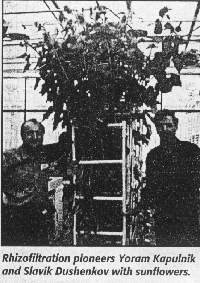Sunflowers root out radiation

Why would anyone want to grow a field of highly radioactive sunflowers?
The engineers who grew them in a pond one kilometer from the crippled Chernobyl nuclear plant
─ an area often called the most radioactive spot on Earth ─ are excited about the possibilities. That’s because this patch of sunflowers marks the first successful field demonstration using terrestrial plants for removing radionu-clides from contaminated water, a process known as rhizofiltration."The results we have seen at this site, as well as a field test in Ohio, suggest that many radionuclides can be substantially or completely removed from water using rhizofiltration ,”
says Burt Ensley, president and CED of Phytotech, a Monmouth Junction, New Jersey-based environmental biotechnology firm.Contaminants are usually removed by ion exchange, reverse osmosis, microfiltration, precipitation or flocculation. But these methods may be difficult to implement and can be prohibitively expensive for large water volumes, low-metal concentrations and high cleanup standards.
Estimates for cleaning up the 60 U.S. Department of Energy sites that have been identified as contaminated suggest costs of $10 billion using current treatment techniques. Even more widespread contamination is present in Eastern Europe, particularly in areas near Chernobyl.
Certain species of plants that grow rapidly have proven successful in accumulating and removing heavy metals from water.
"Sunflowers have shown to be selective in absorbing metal,"
Ensley says. "They were able to absorb heavy metals while leaving others - such as iron -behind. This increased their ability to quickly absorb the radionuclides. And, once they have absorbed the radionuclides,the sunflowers are then stabilized, ashed or vitrified and the resulting radioactive waste is stored in a disposal facility."